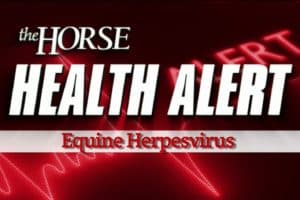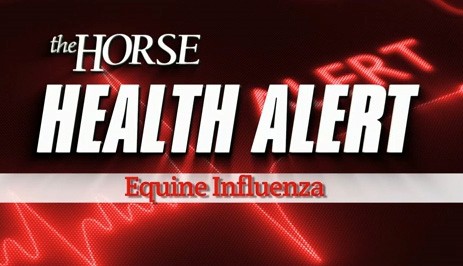Wisconsin Horse Confirmed With Equine Influenza and EHV-4

Wisconsin Department of Agriculture, Trade and Consumer Protection (WDATCP) officials have confirmed a 2-year-old Appaloosa colt with both equine influenza (EI) and equine herpesvirus-4 (EHV-4). The horse, which resided at a private farm in Marquette County, originated from a rescue facility within the last two weeks.
EHV-4 Facts
Herpesvirus is highly contagious among horses and can cause a variety of ailments in equids, including rhinopneumonitis (a respiratory disease usually found in young horses), abortion in broodmares, and equine herpesvirus myeloencephalopathy (EHM, the neurologic form).
The two most common forms of equine herpesvirus are EHV-1 and EHV-4. EHV-1 is the main cause of viral abortion outbreaks and can also result in fever or respiratory signs, which are sometimes followed by neurologic signs such as ataxia (incoordination), weakness or paralysis of the fore and hind limbs, urine retention and dribbling, loss of tail tone, and recumbency (inability to rise). The neurologic form, EHM, is a result of damage to the central nervous system’s vasculature.

EHV-4 usually causes respiratory disease and occasionally can cause abortion or neurologic disease. It is most commonly seen—often in autumn and winter—in weaned foals and yearlings. Older horses with EHV-4 are more likely to spread the virus without showing clinical signs.
Herpesvirus is easily spread by nose-to-nose or close contact with an infectious horse; sharing contaminated equipment including bits, buckets, and towels; or clothing, hands, or equipment of people who have recently had contact with an infectious horse. Routine biosecurity measures, including hygiene and basic cleaning and disinfection practices, should be in place at all times to help prevent disease spread.
Current EHV-1 vaccines might reduce viral shedding but are not protective against the neurologic form of the disease. Implementing routine biosecurity practices is the best way to minimize viral spread, and the best method of disease control is disease prevention.
About Equine Influenza
Equine influenza is a highly contagious respiratory disease that infects horses, ponies, and other equids, such as donkeys, mules, and zebras. The virus that causes it is spread via saliva and respiratory secretions from infected horses. Horses are commonly exposed via horse-to-horse contact; aerosol transmission from coughing and sneezing; and contact with human’s contaminated hands, shoes, or clothes or contaminated tack, buckets, or other equipment.
Clinical signs of equine influenza infection can include a high fever (up to 106°F); a dry, hacking cough; depression; weakness; anorexia; serous (watery) nasal discharge; and slightly enlarged lymph nodes. Consider monitoring your horse’s health at shows by taking his temperature daily, which can help you pick up on signs of infection early and take appropriate measures to reduce disease spread.

Vaccination is an important and inexpensive way to protect your horse. US Equestrian requires proof that horses have had an equine influenza vaccination within the six months prior to attending organization-sanctioned competitions or events. Your veterinarian can help you determine what other vaccines your horse might benefit from.
In addition to vaccinating, following strict biosecurity protocols can help reduce your horse’s chance of infection and disease. Such measures include quarantining new equine arrivals at barns, disinfecting buckets and equipment, and preventing nose-to-nose contact between horses.
Written by:
Edited Press Release
Related Articles
Stay on top of the most recent Horse Health news with












